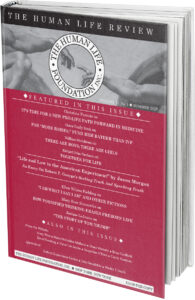Spina Bifida: Where Some Have Led the Way
“The baby won’t live to be fourteen.” Our grandmother would announce her skepticism about my cousin’s life expectancy as easily as she would announce that the weatherman had predicted rain. Of course, there was nothing magic about the age of fourteen—every anticipated milestone age was one my grandmother was sure my cousin wouldn’t live to see. I probably remember fourteen because I was fourteen when my grandmother passed away.
Still, that “the baby,” my cousin, wouldn’t live into adulthood was a simple fact to her. Her saying so didn’t really traumatize our childhood; my cousin was born with severe spina bifida and at that time the prognosis wasn’t exactly great. He was so fragile at birth that the ambulance refused to transport him. On the day he was born, my mother held him on a pillow while my father drove them to a hospital that could better treat him. Our grandmother’s prognosis did not come out of left field.
Nonetheless, growing up, I didn’t exactly believe that my cousin could die. He seemed healthy enough, though he couldn’t walk and had a host of other medical problems that come with spina bifida. He was at least able to withstand regular older-cousin teasing, as he didn’t have any siblings of his own to make his life miserable. Grandma’s pronouncements don’t stand out in my memory as having been traumatic.
What her prognosis did, however, was normalize my cousin’s medical complexities. It was all out in the open. Somehow, I grew to expect that everyone must have a family member with a disability, a difficult prognosis, and maybe an outspoken grandmother. Likewise, without realizing it, I understood that it is impossible to push a wheelchair and open a door at the same time. That countertops are not reasonable workstations from a wheelchair. That some people can break a leg in their sleep, and that the inability to walk has no bearing on the ability to think, speak, and argue. Where my grandmother saw my cousin as weak, I saw him as capable. He learned to tie his shoes the day I sat repeatedly untying them to get on his nerves. He learned to use a microwave when, just to see if he could figure it out himself, I refused to make his popcorn. Whether or not “the baby” lived to be the age I already was, he sure was going to learn to make his own popcorn.
In the 1970’s, when my cousin was born, the normal treatment was to allow babies born with spina bifida to die, and perhaps this would have been the sum of my cousin’s life had he not been carried from one hospital to another on my mother’s lap immediately after his birth. Today, testing for spina bifida is a routine part of prenatal care, and 95 percent of babies diagnosed with the defect in their spinal cord are aborted. Ninety-five percent of babies diagnosed with spina bifida, therefore, never learn to tie their shoes or make popcorn, never have to tolerate an annoying older cousin, and never live to normalize the care and lifestyle of being in need.1
The primary argument for aborting these children is that they would never attain a reasonable quality of life. If that quality is defined by the able-bodied, it includes many things that indeed were out of reach for my cousin. He could never walk, live independently, play in a sports league, or drive a car. Nonetheless, a Centers for Disease Control (CDC) study paints a different picture, allowing the patients themselves and their families to define the term “quality of life.” They report that while “children and young people with spina bifida reported lower health-related quality of life than youth with other chronic health conditions . . . Children and young people with spina bifida reported improvements in their social well-being over time. Their physical and psychological health remained stable. Youth with spina bifida may adapt to their health condition.”2 In other words, given the opportunity and appropriate support, these children can live productive and, more importantly, happy lives.
Recently, a friend with a terminally ill son noted how easily other friends have since slipped away. Mutual friends have commented on how helpless they feel in the face of the child’s suffering. Even my husband has remarked that it is painful for him to see our friend’s son struggle. Because, however, childhood pain and disability were so normalized in my own experience, I have no urge to step away. While I may be terrible at all things medical and biological, I can be present in the moment, not feeling a need to turn away from childhood suffering. In the same way, my eyes do not stop seeing a person when I see a wheelchair or an oxygen tank; I am able to see people, not just the medical accessories of disability.
Without a childhood that normalized the atypical developmental model, I could not imagine an adulthood that would accept the needs of those who suffer, anticipate the struggles of those who have needs, and adapt the world around to encompass those who are not like ourselves in our physical development. Every “disabled” person’s struggle for acceptance makes the way a little smoother for the next person. Everyone who encounters that struggle learns a little more about how to see the world from another perspective.
As it turns out, my cousin did live past fourteen. He still views the world from a seated perspective and reaches up to embrace his friends. He is incredibly active in his local church. As I write this, he just celebrated his forty-third birthday. Because my cousin and others like him were able to survive, medical care for those with spina bifida has progressed tremendously. No longer do grandmothers need to murmur that these babies won’t live or thrive, because some, like her grandson, have led the way.
1 https://www.ncbi.nlm.nih.gov/pmc/articles/PMC2092440/
2 https://www.cdc.gov/ncbddd/spinabifida/data.html











Pingback: SATVRDAY LATE EDITION – Big Pulpit